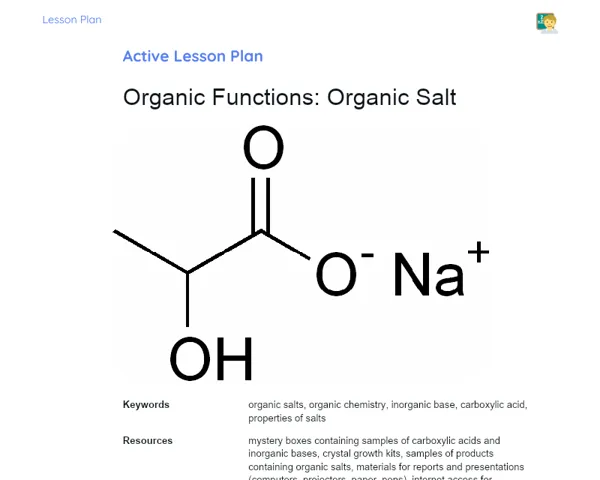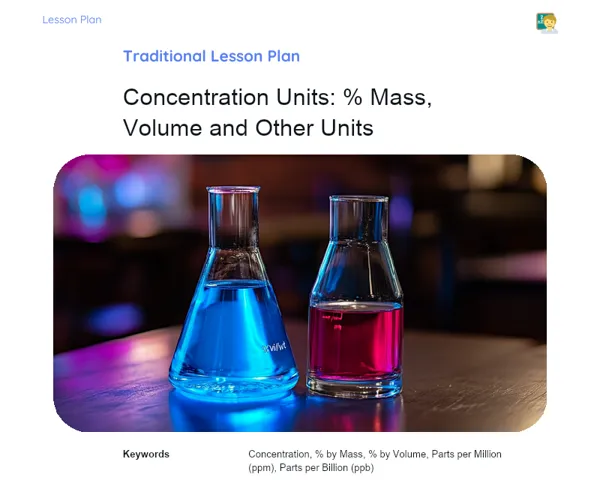Lesson Plan Teknis | Introduction to Organic Chemistry: Classification of Carbons
| Palavras Chave | Organic Chemistry, Carbon Classification, Primary Carbons, Secondary Carbons, Tertiary Carbons, Quaternary Carbons, Molecular Models, Pharmaceutical Industry, Petrochemical Industry, Practical Skills, Maker Activities, Fixation Exercises, Model Building, Structural Analysis |
| Materiais Necessários | Molecular model building kits, Short video on the application of Organic Chemistry, List of printed or projected organic structures, Whiteboard and markers, Paper and pens for drawing molecular structures, Computer and projector for video presentation |
Objective
Duration: 10 to 15 minutes
The aim of this lesson plan stage is to build a solid understanding of how to classify carbons in various organic structures. It's crucial for students to gain practical skills in identification and classification, which are relevant across many job sectors, such as the chemical and pharmaceutical industries. Additionally, it promotes critical and analytical thinking necessary for tackling complex issues in Organic Chemistry.
Objective Utama:
1. Classify carbons as primary, secondary, tertiary, or quaternary.
2. Identify different carbon types in various organic structures.
Objective Sampingan:
- Apply carbon classification in practical problems and exercises.
- Develop skills for structural analysis of organic compounds.
Introduction
Duration: 15 to 20 minutes
The intention of this stage is to pique students' interest by linking the topic to real-life situations and potential careers. This approach aims to ignite curiosity, providing a context that clarifies the importance of the material they'll be engaging with.
Curiosities and Market Connection
Did you know that the classification of carbons is vital in developing new drugs? The position and type of carbon in a medication can directly influence its effectiveness and safety. In the petrochemical sector, understanding hydrocarbon structures helps enhance refining techniques and fuel production. Chemists and engineers use this knowledge daily to create more efficient and sustainable products.
Contextualization
Organic Chemistry plays a crucial role in our everyday lives, from the foods we eat to the medicines we rely on. Understanding how carbon atoms arrange in organic molecules is key to grasping their properties and reactions. This lesson will focus on classifying carbons into different types, which is an essential skill for any chemist and has significant relevance in industries like pharmaceuticals and petrochemicals.
Initial Activity
Kick off the lesson with a thought-provoking question: 'How might the carbon structure in a molecule affect its properties and uses?' Then, show a brief 3 to 5-minute video illustrating the role of Organic Chemistry in the making of a common product, such as a medicine or a biodegradable plastic. Follow this with a short discussion on the students' observations.
Development
Duration: 50 to 60 minutes
This stage allows students to apply the knowledge they've gained practically, cementing theoretical understanding through engaging and challenging activities. By constructing molecular models and engaging in fixation exercises, students will develop crucial analysis and classification skills applicable in fields like pharmaceuticals and petrochemicals.
Topics
1. Primary Carbons
2. Secondary Carbons
3. Tertiary Carbons
4. Quaternary Carbons
5. Identifying Carbons in Organic Structures
Thoughts on the Subject
Encourage students to reflect on the significance of identifying and classifying the different types of carbons in organic compounds. Ask how this skill pertains to careers in the pharmaceutical or petrochemical sectors, and how understanding molecular structure can drive the innovation of new products. Motivate students to consider how this classification aids in understanding the chemical and physical characteristics of materials.
Mini Challenge
Practical Challenge: Building Molecular Models
Students will construct molecular models using atom and bond kits to represent different organic structures. They will identify and classify the carbons featured in each model.
1. Divide students into groups of 4 to 5.
2. Provide each group with molecular model building kits.
3. Ask each group to create three simple organic molecules, such as methane, ethanol, and isobutane.
4. Once the models are built, each group needs to identify the types of carbons (primary, secondary, tertiary, quaternary) in their structures.
5. Have them present their molecules to the class, explaining the classification of the carbons they’ve identified.
Develop practical skills in constructing molecular models and identifying and classifying carbons in organic structures.
**Duration: 30 to 35 minutes
Evaluation Exercises
1. Provide a list of printed or projected organic structures. Have students identify and classify carbon types in each structure.
2. Prepare a series of multiple-choice questions related to identifying carbon types in various organic compounds.
3. Suggest an exercise where students create their own molecular structures and subsequently identify and classify the carbons involved.
Conclusion
Duration: 15 to 20 minutes
The goal of this lesson plan stage is to solidify the students' learning through a review of the main concepts discussed and to connect them to practical applications. The final discussion and reflection reinforce their knowledge and clarify its relevance within both the job market and everyday life.
Discussion
Lead an open discussion with students about the key points from the lesson. Ask what they found particularly interesting and if they faced any challenges in classifying different types of carbons. Encourage sharing of how this knowledge might apply in areas such as pharmaceuticals, petrochemicals, among others. Discuss how the activity of building models and completing classification exercises contributed to their understanding of the content. Facilitate a reflection on the significance of identifying carbon types for the development of more effective and innovative chemical products.
Summary
Wrap up the lesson by reviewing key topics, such as the classification of carbons into primary, secondary, tertiary, and quaternary categories. Remind students of the practical activities they undertook, like building molecular models and conducting fixation exercises, and emphasize how these experiences helped bolster their theoretical knowledge. Explain the connection between theory and practice and its relevance to the job market.
Closing
Conclude the lesson by stressing the importance of the knowledge gained for their daily life, especially in terms of its applications in industry and chemical product development. Explain that the ability to identify and classify different carbon types is foundational for understanding organic chemistry and nurturing innovation in various technological sectors. Encourage students to continue exploring the realm of organic chemistry with enthusiasm and curiosity.



